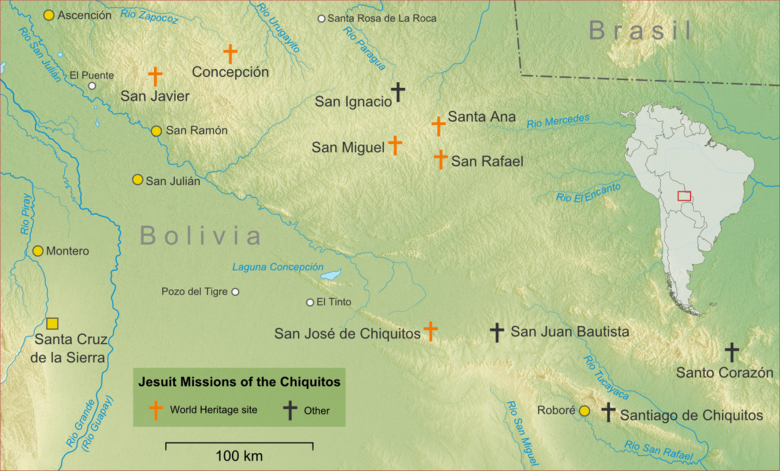Chiquitano language facts for kids
Quick facts for kids Chiquitano |
||||
|---|---|---|---|---|
| Besïro | ||||
| Native to | Bolivia, Brazil | |||
| Region | Santa Cruz (Bolivia); Mato Grosso (Brazil) | |||
| Ethnicity | perhaps about 100,000 Chiquitano people | |||
| Native speakers | 2,400 (2021) | |||
| Language family |
Language isolate or Macro-Jê
|
|||
| Official status | ||||
| Official language in | ||||
|
||||
Chiquitano (also called Bésɨro or Tarapecosi) is a special language spoken by the Chiquitano people. It's an isolated language, meaning it doesn't seem to be closely related to any other language family. You can find people speaking Chiquitano in the central part of the Santa Cruz Department in eastern Bolivia. It's also spoken in the state of Mato Grosso in Brazil.
Contents
What Kind of Language Is Chiquitano?
Chiquitano is usually thought of as a language isolate. This means it's like a unique language that stands alone, not part of a bigger language family.
Some experts have tried to link Chiquitano to other language groups. For example, Joseph Greenberg once suggested it might be part of the Macro-Jê languages family. However, his ideas were later questioned. Other researchers, like Kaufman (1994), thought it might be related to the Bororoan languages. More recently, Adelaar (2008) classified it as a Macro-Jê language, while Nikulin (2020) suggested it might be a "sister" to Macro-Jê, meaning it's related but not directly part of that family.
Different Ways of Speaking Chiquitano
Just like English has different accents or dialects, Chiquitano also has different ways of being spoken. These are called varieties or dialects.
Older Varieties
In the past, people like Mason (1950) and Čestmír Loukotka (1968) listed several varieties of Chiquitano. Some of these included:
- Tao (also called Yúnkarirsh), spoken in places like San Rafael and San Ignacio.
- Piñoco, found in missions like San Xavier and San José.
- Penoqui, which some think might have been a different language entirely.
- Manasi and San Simoniano were also mentioned.
Modern Varieties
More recently, Nikulin (2020) identified some current varieties:
- Bésɨro (also known as Lomeriano Chiquitano) is spoken in the Lomerío region and Concepción. This variety is very important and even has official status and its own spelling rules.
- Migueleño Chiquitano is spoken in San Miguel de Velasco and nearby areas. Sadly, fewer than 30 people still speak it, so it's becoming very rare.
- There are also "Eastern" varieties like Ignaciano Chiquitano (in San Ignacio de Velasco) and Santiagueño Chiquitano (in Santiago de Chiquitos).
- Some unique varieties include Sansimoniano (in the far northeast of Beni Department) and Piñoco, which was spoken in older missions.
Some Chiquitano people prefer to call themselves Monkóka, which means 'people'.
Chiquitano is also spoken in Brazil, in towns like Cáceres and Vila Bela da Santíssima Trindade in the state of Mato Grosso.
How Chiquitano Sounds
Like all languages, Chiquitano has its own set of sounds. It has different consonants and vowels that make up its words.
For example, the language uses sounds like 'p', 't', 'k', 'm', 'n', and 's'. It also has vowels like 'a', 'e', 'i', 'o', and 'u', similar to Spanish.
One interesting thing about Chiquitano is how sounds change when they are near nasal sounds (like 'm' or 'n'). This is called "nasal assimilation." It means a sound can become more like a nasal sound if it's next to one.
Words in Chiquitano are built using simple patterns. They often have syllables that are a consonant followed by a vowel (CV), or a consonant followed by two vowels (CVV), or a consonant, vowel, and then a nasal consonant (CVC).
Chiquitano Words
Here are some basic words in different Chiquitano varieties, collected by Loukotka (1968). You can see how words can be similar or a bit different across the varieties.
| gloss | Chiquito | Yúnkarirsh | San Simoniano | Churápa |
|---|---|---|---|---|
| tooth | oh-ox | oän | noosh | |
| tongue | otús | natä | iyúto | |
| foot | popez | popess | pipín | ípiop |
| woman | pais | páirsh | paá | páish |
| water | toʔus | tush | túʔush | |
| fire | péz | péesh | peés | |
| sun | suur | suursh | sóu | súush |
| manioc | tauax | táhuash | tabá | tawásh |
| tapir | okitapakis | tapakish | oshtápakish | |
| house | ogox | póosh | ípiosh | |
| red | kiturixi | kéturuk | kéturikí |
How Chiquitano Connects with Other Languages
Languages often borrow words from each other, and Chiquitano is no different! It has borrowed many words from a type of Tupí-Guaraní language. For example, the Chiquitano word takones (meaning 'sugarcane') sounds a lot like the Guaraní word takuare'ẽ. Chiquitano has also borrowed many words from Spanish.
Interestingly, Chiquitano has also influenced other languages. The local Spanish spoken in Bolivia, especially the Camba variety, has many words that originally came from Chiquitano. Some examples include:
- bi (a type of fruit called genipa)
- masi (squirrel)
- peni (lizard)
- peta (turtle)
- jachi (leftover drink)
- jichi (worm or a special spirit)
These borrowed words show how languages can share and mix over time!
See also
 In Spanish: Idioma chiquitano para niños
In Spanish: Idioma chiquitano para niños


